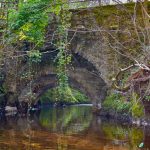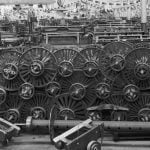When the mill was first built on the tail laid of the Lornty mill in the mid-1840s it had a hydro-mechanical turbine (not a traditional water wheel). This was reported to have been the first of its type in Scotland. That was then replaced with a hydro-electric turbine in the early 20th Century. Water was conveyed from the dam to the mill through a pipe about 2 feet in diameter. The water wheel was known as a “Whitelaw and Stirret’s reaction wheel” being, it is said, an improvement on the original Barker’s wheel.
The wheel was 5 feet in diameter being situated on the lower end of a vertical shaft running up the gable of the mill. Water was conducted to the lower side of the wheel which it entered at the centre, and left it through tangential orifices on its circumference. The surface of the water in the dam when full was 40 feet above the level of the wheel giving a pressure of about 20 lbs. per square inch. This gave the wheel 180 revolutions per minute which produced nearly 25 horse power. In January, 1901, this wheel was succeeded by a “Hercules” turbine which yielded more power from the same amount of water. New machinery was also added and the mill was lit for the first time by electricity.
After 1904, Brooklinn worked in conjunction with Ashbank Mill a little further down the river. Some of the processes in spinning were performed in Brooklinn and then the material was transferred to Ashbank. With the burning down of the latter in about 1918, Brooklinn was closed.
Brooklinn Mill is interesting mainly from the aspect of water power. Driven by water from the Lornty burn, its power would have been insufficient had it not been for the construction of two big dams. The dam in the ravine beside the mill itself supplied the immediate power but this was usually sufficient to last only one day in dry weather. However, to ensure a steady supply even in summertime, another large dam was built above the Lornty weir to act as a reservoir for both mills. Considering the size of the lade and Lornty Mill itself, it may be that this larger dam was built about the same time as the Brooklinn dam as it is possible that sufficient water could always be obtained to drive the small Lornty Mill without the presence of a large weir. However, the Lornty dam ensured a steady supply of water to both mills. It was customary in the summer for the Brooklinn dam to be closed at night in order to be filled ready for work in the morning.
Since 1870 Blairgowrie’s water supply has been obtained from Loch Benachally at the head of the Lornty Burn, and from that date till the closure of the Lornty and Brooklinn mills there tended to be a scarcity of water in dry summers for both the town’s water supply and what was required to keep the two mills running. After the installation of the turbines in both mills in 1901, which required a steady supply of water in order for the machinery to work properly, and the rather dry summer of 1905, difficulties arose in maintaining sufficient supplies for both town and mills, resulting in a court action between the Town Water Board and the proprietor of the mills. (Blairgowrie Advertiser, July 21, 1906).
Both Brooklinn and Lornty dams became derelict. Brooklinn dam burst about 1931 and Lornty dam in 1948 due to neglect and the accumulation of sediment at the base of the wooden structures.
Brooklinn mill was taken over in the early 1960s and restored and re-equipped. A concrete dam was constructed to harness the water of the Lornty burn. A diesel engine was installed and electricity was generated to power the machinery which spun rayon yarn for the pile of tufted carpets. Unfortunately, despite the upgrading the mills could not compete with cheap imports or the large modern factories. Production in Blairgowrie declined and was concentrated in the two remaining mills owned by the Thomson company. The Brooklinn mill finally closed in 1979.
The mill buildings have since had several transformations and currently serve as a family home with a holiday letting business in the adjacent (jute) store.
Of interest are the remains of two buildings along the river path that served Brooklinn Mill: one is the Manager’s House [Arnbank house] which was ‘tumbled’ ten years ago as it was considered unsafe and the other is a significant outline of the tenements which housed workers at this mill and the next mill Ashbank. Whin stone from the nearby Knockie quarry was used for these buildings. The tenements are of interest as they were built into the hillside so we see two storeys from the path but three storeys from the riverside. They are unique in Scottish mill colonies – the only other site is at New Lanark where they are on a bigger scale.



